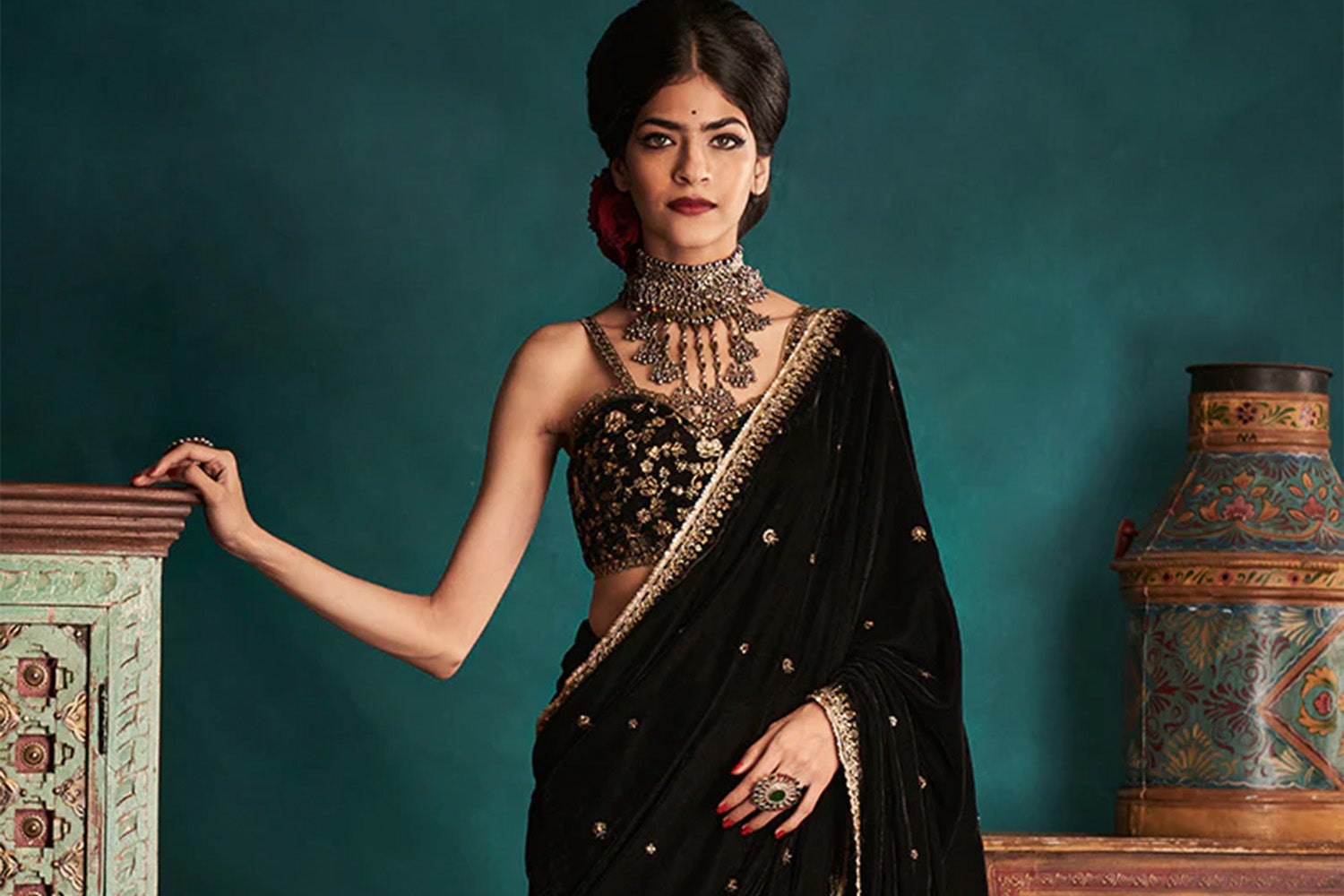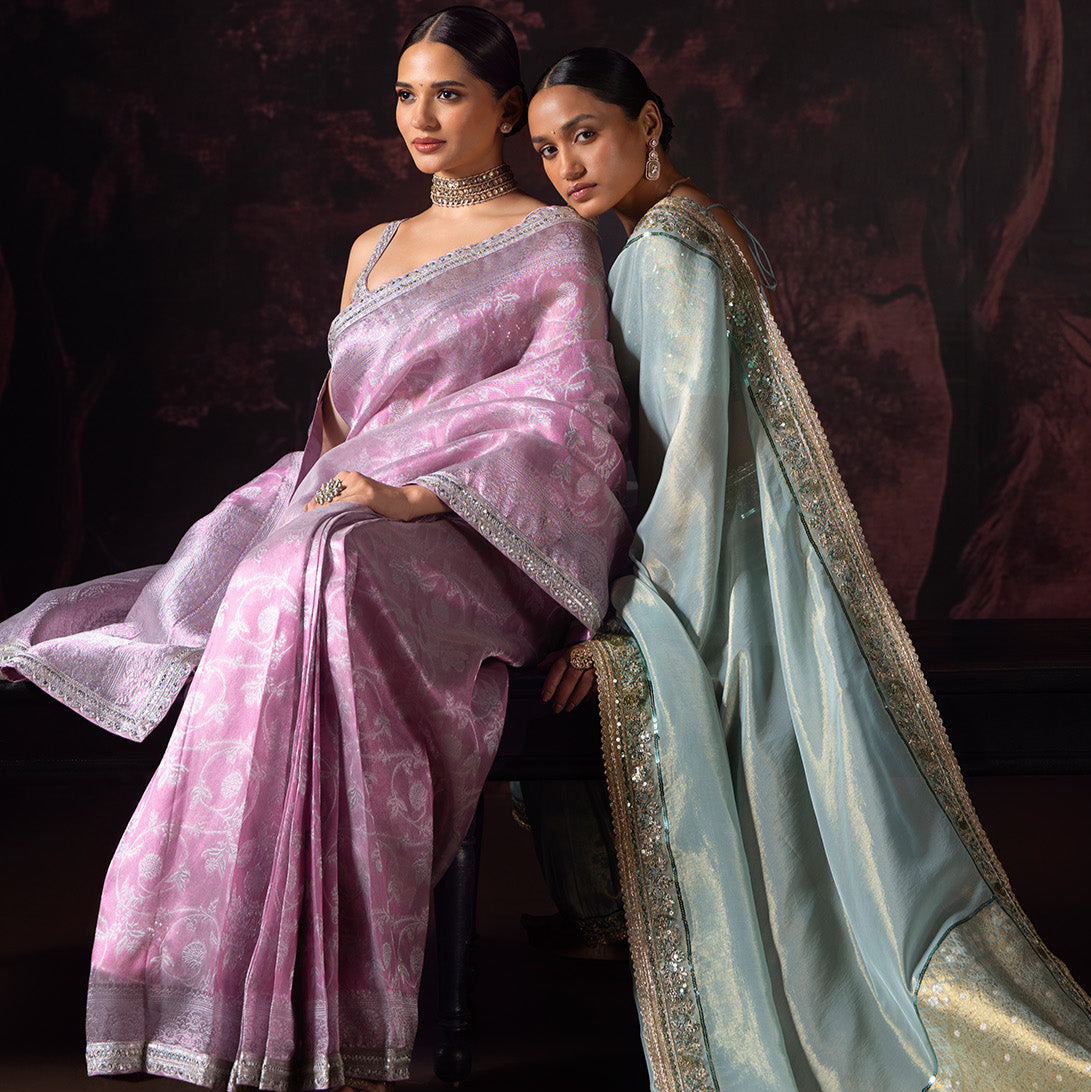
Half Saree vs. Full Saree: What Is the Difference?
Sarees are a timeless and elegant traditional Indian dress style that has been worn for centuries in India and other parts of South Asia. With their limitless draping silhouettes and refined charm, sarees are a popular choice for many women for both everyday wear and formal events.
But with so many styles available, it can be difficult to know where to start. You might be wondering, what’s the difference between a half saree and a full saree?
Whether you're a seasoned saree-wearer or new to the world of sarees, keep reading for all the information and inspiration you need to create a stylish saree look.
What Is a Saree?
A saree also spelled sari or shari, is a long piece of fabric that is draped around the body and worn as a traditional garment in South India. Think of it as a stylish wrap skirt that can be dressed up or down, depending on the occasion.
The saree is usually made of cotton, silk, or other fabrics and ranges in length. It is typically paired with a blouse, called a choli, and a scarf, called a dupatta or pallu. Sarees can be draped over so many different styles of skirts and pants, from a lehenga to a salwar suit. A midriff-bearing lehenga choli looks particularly fashion-forward layered under a saree.
Sarees are super versatile and can be styled in seemingly infinite ways, from traditional to modern. You can switch up your colors, fabrics, and draping techniques, to create a unique and personal look every time.
What Are the Different Types of Sarees?
Sarees come in many shapes and sizes with a range of embellishments. While there are seemingly limitless ways to drape it, sarees are mostly placed in two categories: the half saree and the full saree.
What Is a Half Saree?
A half saree is what its name implies. It’s about half of the material of a full saree and is often worn by young girls and women. It's a fun and playful version of the traditional saree.
A half saree is sometimes referred to as a langa voni, a pattu pavadai, or a two-piece saree, depending on the material and the area. The half saree is worn with a blouse and a dupatta. Half sarees are generally a little easier to drape, especially for beginners.
But just because young women typically wear half sarees doesn’t mean they’re all made for children. Check out this Black and Dusty Mint Velvet saree, for example. With beautiful zari work and floral motifs, this half saree can be the star of any wardrobe.
The half saree is also great if you're looking to experiment with a wide range of colors and prints. They are often made with lighter fabrics, like chiffon, georgette, crepe, and even art silk, making them perfect for warmer weather.
What Is a Full Saree?
A full saree is the traditional and complete version of the saree.
The full saree generally consists of a saree, a blouse, and a dupatta. The saree is draped around the waist and over the shoulder, with one end of the saree, called the pallu, draped over the head or shoulder. The saree is often worn with pleats at the back.
The full saree can be made of various fabrics like cotton, pattu, georgette, crepe, and chiffon, and it can also be embellished with various types of embroidery, beadwork, or prints. The material you choose will have a big effect on the overall look. Take a look at this Black and Gold Velvet Saree versus this White and Pink Silk Saree. With opposite fabrics and prints, you have totally different looks.
Your silhouette and draping possibilities are also opportunities to show off your personality.
Styling and Accessorizing a Saree
There are so many occasions that call for sarees. A full wedding saree should be formal, while a family party half saree can be casual.
When Should You Wear a Half Saree?
A half saree is perfect for more casual events, such as family gatherings, lunch or dinner parties, or even for a day out with friends. It's also well-suited for outdoor events, like picnics, or even just a day spent at the park.
You can add a touch of elegance with traditional jewelry and a formal blouse, or keep it more casual with simpler accessories and a more relaxed blouse.
It can also be worn as everyday attire by young girls and young women who want to add a traditional touch with a modern feel.
When Should You Wear a Full Saree?
A full saree can be worn for many types of occasions.
The full saree is perfect for formal events such as weddings, engagement parties, and traditional ceremonies. It's also an excellent choice for special occasions like anniversary parties, birthdays, and other celebrations. Many women even wear saree looks to work to showcase a more formal style.
It's also a fabulous option for those who want to make a fashion statement, as a full saree can be adorned with various types of accessories.
What Accessories Pair Well With a Saree?
Speaking of, let’s talk about accessories.
One traditional accessory that pairs well with a saree are bangles. Another traditional option is earrings, like these Polki earrings, which will draw attention in the best way. Try to pair the colors in your saree with the colors in your earrings. For example, this Kundan Necklace Set would pair perfectly with a saree with green and gold embellishments.
Footwear also plays an important role in completing your saree look. Whether it's traditional juttis, mojari, or stilettos, it can make a huge difference.
When it comes to accessorizing a saree, the key is to have fun and experiment with different styles and combinations.
What Are the Right Occasions for Wearing a Saree?
One of the most popular occasions for wearing a saree is a wedding. A lehenga saree can be the perfect attire for a bride or a wedding guest, as it's traditional, flattering, and feminine.
Another popular occasion for wearing a saree is a ceremony, like a pooja, a festival, or a religious event. Sarees are also popular for parties and for work, as the draping and accessories can drastically alter their silhouette and effect.
With the right draping and styling, a saree can be transformed into modern and fashionable attire. It’s perfect for young women who want to incorporate traditional Indian clothing into their everyday wardrobe.
Whether you're attending a wedding or a traditional ceremony, a party or a formal event, or just looking for stylish and comfortable everyday wear, a saree is a perfect choice.
Make Your Traditional Indian Wardrobe Complete
In both North Indian and South Indian cultures, sarees play important roles in both everyday and formal wardrobes. From Bollywood films to family reunions, sarees are an absolute staple.
No matter what you’re looking for, a half saree or a full saree, remember to bring a sense of originality and personality to your look. Nothing completes a saree better than a little confidence.
Browse through our entire collection of sarees here.
Sources:
The History Of Sari: The Nine Yard Wonder | India Times
What to Wear to an Indian Wedding as a Guest | Brides
Indian Dupatta: Its History, Styles And Versatile Uses | Utsavpedia














